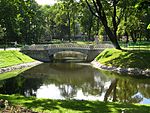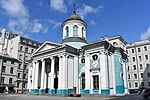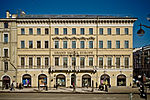Mikhailovsky Palace

The Mikhailovsky Palace (Russian: Михайловский дворец) is a grand ducal palace in Saint Petersburg, Russia. It is located on Arts Square and is an example of Empire style neoclassicism. The palace currently houses the main building of the Russian Museum and displays its collections of early, folk, eighteenth, and nineteenth century art. It was originally planned as the residence of Grand Duke Michael Pavlovich, the youngest son of Emperor Paul I. Work had not yet begun on the Mikhailovsky Palace, when Paul was overthrown and killed in a palace coup that brought Michael's elder brother to the throne as Alexander I. The new emperor resurrected the idea for a new palace by the time Michael was 22, and plans were drawn up by Carlo Rossi to develop a new site in Saint Petersburg. The palace, built in the neoclassic style, became the centrepiece of an ensemble that took in new streets and squares. It was lavishly decorated, with the interiors costing more than the main construction work. It was gifted to Grand Duke Michael and his new wife, Grand Duchess Elena Pavlovna, by the Emperor in 1825. The grand ducal family had comfortable apartments furnished to their individual tastes. Grand Duke Michael carried out some of his military duties there, while his wife hosted salons that brought together many of the leading members of Saint Petersburg society and culture. The Grand Duchess continued this lifestyle after her husband's death in 1849, until her own death in 1873. The palace was passed on to the couple's daughter, Grand Duchess Catherine Mikhailovna. Over the years of their residency, the family renovated and refurbished the palace's rooms in keeping with contemporary tastes. By the time of Grand Duchess Catherine's death in 1894, the staterooms were no longer in regular use—the family resided for the most part in the palace's wings. With the death of the Grand Duchess, the palace was inherited by her children, who were members of the family of the Dukes of Mecklenburg-Strelitz. Concerned about the palace passing out of the Romanov family, Emperor Alexander III decided to buy it back for the state. He died before this could be arranged, but the negotiations were carried out on behalf of his son Emperor Nicholas II, by Minister of Finance Sergei Witte. Nicholas gave it to the newly established Russian Museum, in honour of his father, with the remit that it collect and display domestic art. The palace was extensively renovated to fit its new role, with some of the interiors retained. One wing was demolished and rebuilt, later becoming the Russian Museum of Ethnography, while a new extension, the Benois wing, was added in the 1910s.
Excerpt from the Wikipedia article Mikhailovsky Palace (License: CC BY-SA 3.0, Authors, Images).Mikhailovsky Palace
Engineering street, Saint Petersburg
Geographical coordinates (GPS) Address Phone number Website Nearby Places Show on map
Geographical coordinates (GPS)
| Latitude | Longitude |
|---|---|
| N 59.938611111111 ° | E 30.332222222222 ° |
Address
Русский музей
Engineering street
191186 Saint Petersburg (Palace District)
Saint Petersburg, Russia
Open on Google Maps











